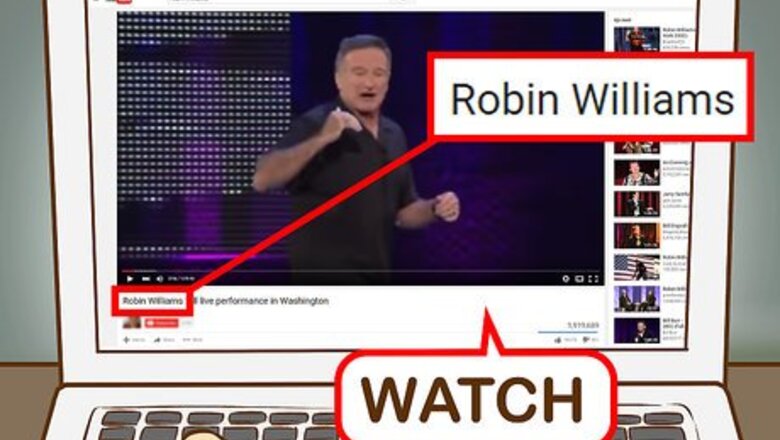
views
Preparing to Write Comedy
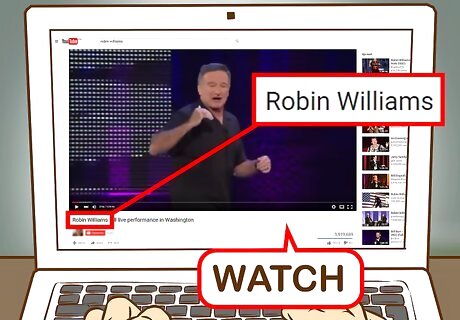
Watch and listen to comedy specials and stand up. In today’s digital age, there are a million and one aspiring comedians on YouTube, Facebook, Twitter and other social media. But not all of them are good. So ask friends with a good sense of humor to recommend their favorite stand up specials or sketches. Look at comedians who are popular right now, as well as legendary comedians of the past. Some examples may be: Robin Williams was an American comedian and actor skilled at physical comedy and the ability to breathe incredible energy into even the most straightforward jokes. Williams was also highly skilled at improvisation and impressions that require a lot of nerve and confidence to pull off in front of a crowd. Louis C.K. is an American comedian with several highly successful stand up specials. His jokes are known for their dry, dirty humor and smart commentary on everyday life. He also writes, directs, and produces “Louie”, a show that blends sketch comedy with the tragedy and pathos of being a divorced comedian and father in New York City. George Carlin is considered one of comedy’s greatest performers, using inflection and tone to add punch to a joke. At his prime, Carlin was able to tease out the nuances and ironies of middle class America, combining big laughs with philosophical truths about the world. Roseanne Barr is a stand up comedian and actress best known for her groundbreaking sitcom “Roseanne”. Her stand up specials are known for their hilarious approach to blue collar humor and Barr’s blunt, entertaining stage presence plays off of her smart, nuanced material.
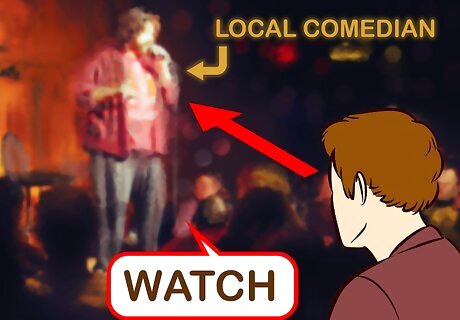
Go see local comedians in your area. Seek out the comedy night at your local bar or amateur stand up at a local venue. Expose yourself to the material of other comedians just starting out. Watching and listening to other comedians will affect how you write and perform comedy. If anything, you will learn what jokes worked well on an audience and which ones flopped.
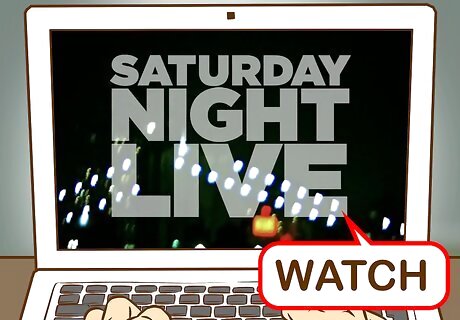
Become familiar with successful sketch comedy shows. Another great resource for your own comedy writing is looking at the successful comedy shows that have come before you. Don’t limit yourself to American comedy shows or only the prime time shows. Look at successful sketch comedies from overseas and online series, also known as web series. “Mr. Show” is a sketch comedy from the mid 90s that introduced major comedic talents like former SNL writer Bob Odenkirk, stand up comedian David Cross, and comedic actor Jack Black. The show’s ability to push boundaries and take on taboo subject matter distinguished it from more traditional sketch comedy shows. “Chapelle’s Show” is the brainchild of comedian Dave Chapelle, and each episode is packed with memorable sketches that riff on everything from the persona of Rick James to a blind black white supremacists. Chapelle never shies away from exposing the ironies and cruelties of modern life during the three excellent seasons of his show. Beyond their social commentary, his sketches also showcase a wicked sense of humor. “Saturday Night Live” is a live sketch show that airs every Saturday night. Now in its 40th year, SNL has launched the careers of many of the biggest comedy stars and given viewers some of the most memorable sketches ever on air. “Funny or Die” is a comedy website that creates hilarious and inventive sketches that become viral videos overnight. Taking on topics ranging from racism in America to frat culture to singles dating culture, Funny or Die is one of the top sites for web comedy today. “Broad City” began as a web series starring comedians Abbi Jacobson and Ilana Glazer, both veterans of the improv scene. It gained a cult following online and developed into a full fledge sketch comedy show on Comedy Central, currently in its third season. The two “broads” of the title, Abbi and IIana, navigate friendship, feminism, dating, and the elusive search for a decent NY apartment in a bold new way.

Analyze the work of other comedians. Now that you’ve split your sides watching the incredible comedic talents of other performers, look closely at each stand up routine and each sketch. Focus on the characters, the setting, the tone, and the punch line of each joke or sketch. Does the joke use a simple, common setting or a more absurd setting? Is the focus of the sketch on one particular character or a cast of characters interacting with each other? Do the characters begin with a punchline or work their way up to the punchline? Look at how the comedians use comedic timing to get a laugh. Each comedian may have a different approach to timing. They may pause before the punchline or speed up their voice. Another major aspect of successful comedy is comedy that is well written and performed well. Robin William’s timing, for example, will be different than Roseanne Barr’s timing. Yet both performers manage to get big laughs from their audience.
Writing Jokes
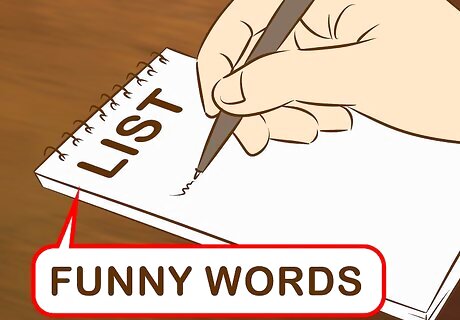
Create a running list of words and phrases. Carry a notebook around with you and write down anything you see or hear that makes you chuckle, cringe, or smile. Take notes on your interactions with friends and family or sit in a crowded area with strangers and observe their behavior. This will help you avoid the dreaded blank white page. It’s much easier to write jokes if you start from a place of ideas, rather than empty pages. Write down punchlines or one-liners. Write down situations and moments you find funny or amusing.

Understand the basic joke structure. Every joke can be distilled down into three parts. They are: The Setup: establishes the premise of the joke by providing the audience with the necessary background information. The setup should be as short and tight as possible. You want to establish the context for the joke without rambling on too long. The Punchline: This is the big laugh line. The setup should lead the audience to one direction, and then you should surprise them by going off in a different direction. The twist, or element of surprise, is a key part of the punchline. Tags: also known as toppers, tags are additional punchlines. Sometimes they build on the original punchline. Sometimes they take the punchline into a surprising new direction or observation. Good comedians can come up with many tags to a joke.
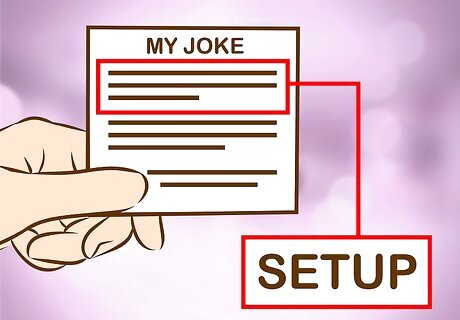
Write a short and effective set up to the punchline. Pay attention to the language you use in each sentence of the set up. It could be as simple as “I was walking down the street the other day…” or more complex, such as “I was stuck on a train the other day with my mother and…”. For example, Jerry Seinfeld, of “Seinfeld” fame, breaks down a joke about Pop Tarts that took him 2 years to write. He pays close attention to the language he uses to set up the joke so he opens the joke with funny moments right away. Rather than say: “I love Pop Tarts and let me tell you why,” Seinfeld starts with: “When I was a kid and they invented the Pop Tart, the back of my head blew right off.” This opening line works because it establishes the time frame (Seinfeld as a kid), it establishes the subject of the joke (the Pop Tart), and it has a unique, specific detail that engages the audience (the back of his head blew right off). The next sentence of the set up then pushes the audience towards the punchline and keeps them laughing with specific, funny details. “When the Pop Tart suddenly appeared in the supermarket, we just stared at it like an alien spacecraft, we were like chimps in the dirt playing with sticks.” The inclusion of details like “chimps in the dirt playing with sticks” keeps the set up entertaining and interesting for the audience.
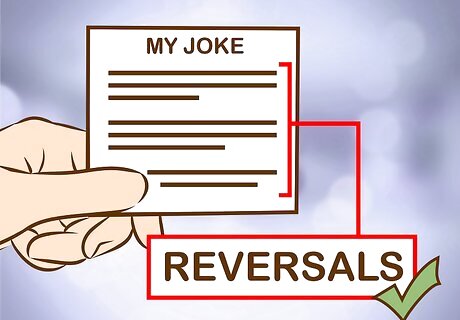
Create reversals in every joke. All comedy is based on reversals, where you take the audience’s expectations and challenge them. Work against the audience’s expectations so they are surprised by the punchline and will laugh. To generate some reversals, choose a problem or issue you’d like to address. Think about illogical ways to address this problem or issue. Maybe you want to talk about the time you broke your leg. Start at the end of the alphabet and list one illogical way for each letter. This could be: In a ZEBRA stampede, slipping on nonfat YOGURT, in a XYLOPHONE accident, WEARING pantyhose that were too tight, etc. For example, take this one-liner from the comedian B.J. Novak: “Battered women: delicious.” Novak introduces the concept of battered women, a common term. He then reverses a common concept with one word: “delicious”. In one word, Novak takes the audience’s expectations and works against them. The term “battered women” now has a completely different meaning in the context of the joke.
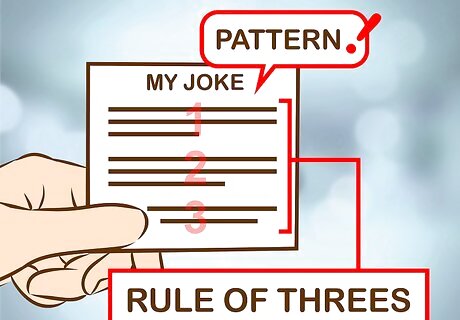
Use the Rule of Threes. The rule of threes is a powerful rule in comedy. In a longer joke, you can establish a pattern by having two attempts or tries in one sketch. The audience will then start to make assumptions on what will happen next. The third attempt or try should break that assumption and cause the audience to laugh. For example, a simple rule of three joke could be: “When people find out that I’m an Indian, people think I practice Yoga, I meditate, and I’m poor… (pause). The third one is correct!” This joke is funny because it sets up three common assumptions people have about Indians and then uses a comedic pause to great effect before the punchline. Create your own rule of threes joke by looking at your list of words and phrases. Choose three words or phrases that relate to each other and see if you can come up with a way to use an assumption about one of the terms and challenge it.
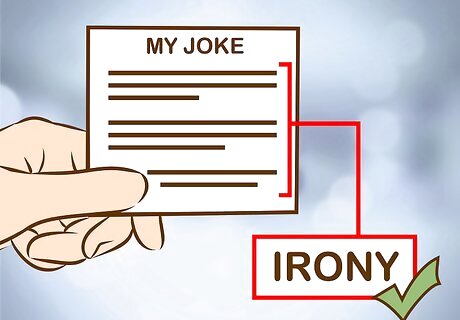
Inject irony into the joke. Irony is the gap between intention and expression, or intention and results. It is one of the most common reversal techniques used by comedians to get a laugh. So don’t be afraid to use irony in a joke whenever possible to create a great punchline. For example, an ironic joke might be a dentist who wakes up to discover he lost a front tooth during a wild night out. Or a highly OCD character who ends up in a pile of vomit at a party. Take a character’s worst-case scenario and make it a reality in the sketch. Steve Martin Steve Martin, Comedian Understand the limits of comedy–then push those limits. "What is comedy? Comedy is the art of making people laugh without making them puke."
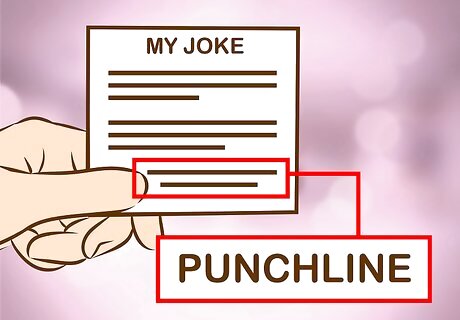
Finish the joke with a big laugh. This seems obvious, but it can be difficult to write a punchline that is as good as your setup. A good punchline will challenge the audience in a new way. Your audience should leave the joke with a new take on the subject in your setup. Avoid obvious jokes or familiar punchlines. For example, the punchline of Jerry Seinfeld’s Pop Tart joke involves a small joke, followed by the big, final joke: “Once the Pop Tart came into the world, I didn’t understand why we were eating other kinds of food. Two Pop Tarts in the packet, two slots in the toaster. Why two? One’s not enough and three is too many, and they can’t go stale because they were never fresh.” Seinfeld works off the set up to move into a smart, funny remark and then ends with a conclusion to the joke that is both true and funny. The audience is left with a new outlook on Pop Tarts. In five sentences, Seinfeld explores his obsession with the Pop Tart and challenges the audience’s assumptions of the Pop Tart.
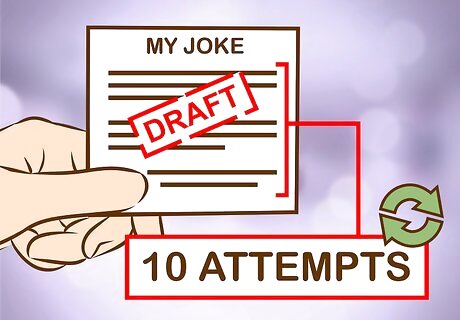
Write at least 10 attempts at one joke. It takes most comedy writers about 10 attempts at a joke to create the funniest punchline possible. In other words, it takes time to find the punchline to a joke. It took Jerry Seinfeld, a seasoned comedian, two years to come up with the best punchline for a joke about a Pop Tart! The more you practice writing jokes, the better you will get at identifying the reversal in a setup. You can then write towards the punchline of the joke and find the line that will get the biggest laugh. You can also use the rule of 10 for brainstorming ideas for jokes. Practice coming up with 10 good joke ideas a day or a week. Focus on developing 10 one liners a month.
Writing Sketches
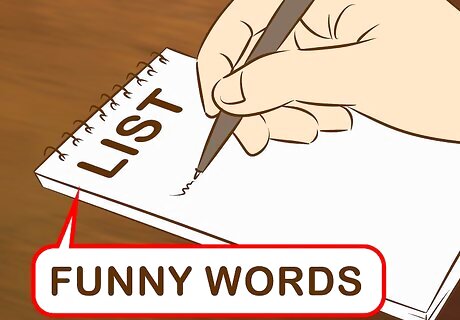
Keep a running list of words and phrases. Carry a notebook around with you and write down anything you see or hear that makes you chuckle, cringe, or smile. Pick three words or phrases from the list and write down everything you can think of about those words. For example, you may choose children, sandwiches, and divorce. Think about any funny or bizarre moments with your children or other people’s children. Consider your favorite sandwich and why it is your favorite. Think about how your relationship with your partner would be affected by a divorce, or if you are single, how divorce affects other couples. Once you have filled a page on each topic, look over your notes and decide which one is the strongest idea. Place this idea on the top of the pile and use it as your main topic.

Look for real life characters who would make great characters in a sketch. The barfly who frequents your local watering hole, the driving instructor who falls asleep on the job, or even the old woman who lives alone in your building could all be good real life examples of sketch characters. Focus on individuals who seem original or interesting to you. Then, write down how you imagine their day to day life to be, based on your observations of them.

Choose a unique setting. Avoid common set-ups like the emergency room or a bar, unless you have something groundbreaking to say about these familiar settings. Look for more original settings like the top of a mountain, the bottom of the ocean, or the President’s secret bedroom in the White House. Use only one central location for the sketch. This will allow you to maximize all the possibilities of one location for the sketch.

Keep your cast of characters to between 1 and 3. Start by creating a two-minute sketch with 1 to 3 characters. This will ensure the sketch isn’t too long and too complicated. If you are looking to sell your material to a network or studio, avoid including expensive props like a helicopter or a mechanical shark. Even if you are writing the sketch for a web series, you will likely not have the budget for expensive props or settings.

Decide which type of sketch you’d like to write. There is no one way to write a comedy sketch, but there are several tried and tested formats, such as: Escalation: A seemingly simple, funny idea starts small and gets bigger and bigger, ending in a chaos of absurd proportions. A good example of this would be the Mr. Show sketch about a pre taped call in show. The set up is simple but it soon escalates into a more and more ridiculous scene as the sketch goes on. Lists: A sketch where most of the dialogue is a long list of funny items. A good example of this is the “Cheese Shop” sketch by Monty Python, a groundbreaking British sketch comedy troupe. A Fake Commercial: SNL does many fake commercial sketches, where they take a common product like Tampons or yogurt and create a parody of the standard commercial format. For example, their parody of medication commercials. A Character sketch: The sketch centers on the persona of a persona or character, such as Steve Martin’s “Wild and Crazy Guy”, Bill Murray’s “Nick the Lounge Singer”, and Alex Borstein’s “Ms Swan” character from MADtv. An Intellectual sketch: Take a historical figure and create a comedy sketch that imagines certain moments in history, such as the “Das Negroes” sketch by the comedy duo Key & Peele. Or a sketch that sheds a different light on the audience’s assumptions about a historical character, such as Steve Martin’s “Socrates” sketch.
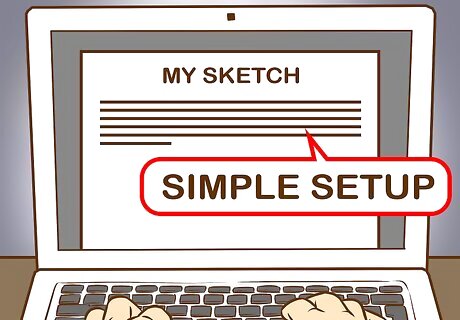
Start with a simple premise or set up. A simple premise allows you to escalate and explore the situation throughout the sketch. It’s also a good idea to start simple if you are writing sketches for the first time. If you decide to write a character sketch, avoid starting your sketch with the character’s catch phrase. This may come across as forced and you may end up with a one joke character. Try to create a multifaceted character who has several catchphrases. This way the audience is surprised by the character throughout the sketch.

Brainstorm ideas with someone who makes you laugh. It can be difficult to write a comedy sketch on your own. Many successful comedy writers work with a writing partner or a room of other writers to come up with the best setups and punchlines possible. If you and another writer make each other laugh, share a similar sense of humor and can support each other’s idea, you could make good writing partners. If you end up working with a writing partner, make sure you agree who is the head writer and who is the co-writer for a particular sketch.
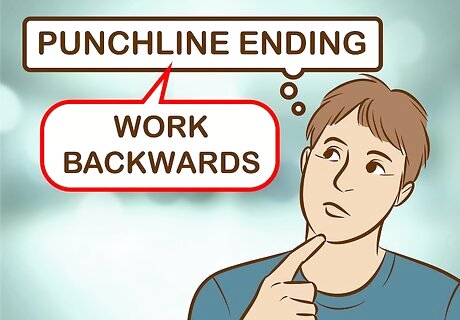
Work backwards. All sketches should have a strong finish. So think about the punchline first, before you write the beginning or middle of the sketch. If you can’t think of a good punchline for a sketch idea after ten minutes, there may not be a good punchline and it may not be an idea worth pursuing. Once you have a funny ending to the sketch, work on how to get there. Write the line immediately before the funny end line. Once you have the last ten seconds of the sketch, work on the beginning of the sketch.

Work out loud. Say the lines out loud as you write them. Or read the sketch and act it out with your writing partner. Listen to how the character voices sound. Note where a pause or a physical action could amp up the laugh factor. Don’t be afraid to have the characters riff off of each other in a setting, especially in the early drafts of the sketch. Playing around with the character interactions and voices can lead to funny moments and make the sketch better.

Edit and rework the sketch. Look over the completed sketch. Make sure there is a strong line in the first several lines of dialogue. Or an action that will get a laugh in the first 15 seconds of the sketch. Put the sketch aside and then return to it the following day. Does it still read as funny as you thought it did last night? If not, rework it. Use the actions of the characters to escalate the sketch to an even more absurd punchlines. Or use the catch phrases of a character to keep the sketch punchy and funny.
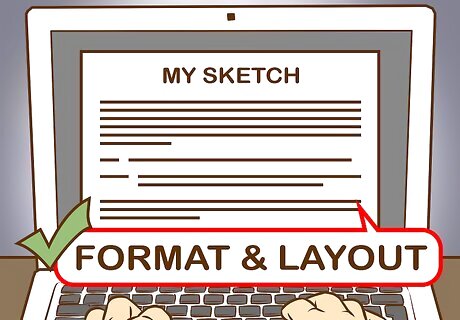
Format and lay out the sketch. If you’re trying to sell your material, it’s important to lay it out properly for a pitch. Put your name and address on every sheet. Number the pages. Use capitals to describe the location and the action. Use capitals for character names. Keep the dialogue and all other description in lowercase.
















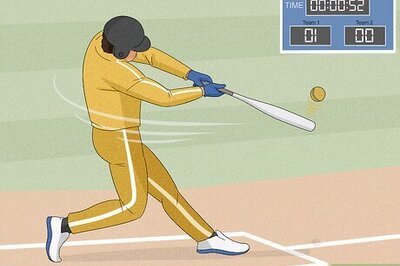
Comments
0 comment